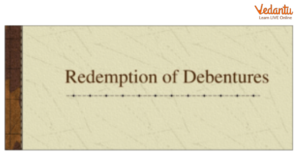




Debenture Redemption: What does It Mean?

Debenture Redemption
Redemption of debentures occurs when a company eliminates its debt to debenture holders by paying off the holders in total. Ordinarily, debentures are repaid at the end of a particular time set when the debentures are issued. The terms of the debenture issuance specify the date of redemption. Before the redemption date, debentures may be redeemed via a lottery or open market acquisition. The debentures may be cancelled or converted into equity shares after the market acquisition.
What are Instalments by Draw of Lots?
To better plan for cash flow, some companies use a revenue recognition strategy called the instalment method, which delays the recording of gross profit on a sale until the owner receives payment from the customer. Using the instalment approach, income is progressively recorded as payments are accepted.
The instalment method is often utilised when a client has been granted authorisation to pay an invoice in periodic payments spread over several years. There is a high possibility that the seller will be unable to collect the entire amount due in some instances. Due to the potential for loss, the company prefers not to record the whole debt amount at the transaction's time. The organisation may reduce this risk by using the instalment method of revenue recognition.
Aspects Influencing Redemption
The following are important considerations at the time of Redemption of Debentures:
Time - The date by which the debentures must be redeemed is the most critical factor. The company must specify debentures' terms of validity at the time of issuance. The debenture holder receives a certificate that specifies the debenture's maturity date and other terms.
Amount - To calculate the redemption amount owed to the holder, we need to make some educated guesses at that moment. The payments consist of both the principal and interest owed.
Source - The redemption amount and how it is repaid are also crucial factors. Therefore, redemption options will vary significantly based on urgency and practicality.
The redemption process will go more smoothly if the organisation has planned and made the necessary preparations.
Debenture Issuance and Redemption Procedures

Redemption of Debentures
Step 1: A Need for Long-Term Funding
The availability of funds in the debenture redemption reserve account is crucial to the effective running of the organisation. For this reason, they must have access to long-term capital to invest in the company's future.
Step 2: Debentures are Issued to Generate Funds
Businesses raise capital through issuing debentures, both convertible and nonconvertible. The corporation then gives Debenture Certificates. Debenture issuance and redemption details are included on the certificate.
Step 3: The Payment Deadline
Debentures are issued for a certain period and will mature on that date. After this period ends, the business promptly redeems all outstanding debentures. The debenture certificate will provide the redemption date for the holder's use.
Step 4: Redeeming Resources
The firm investigates potential debenture redemption channels if needed. In other words, whether the corporation would spend its cash on hand or issue new shares or debt.
Step 5: Redeeming Techniques
For the sake of salvation, this is the most critical step. The best option for the organisation would be one that would not compromise its current financial standing. The four options for redeeming debentures mentioned above are the most common ones.
Illustration
On 01/01/2019, ABK Limited issued 12,000 Debentures for $100 each, with a maturity date of 01/01/2022. However, the corporation wants to redeem the debenture ahead of the redemption date. Therefore, find a way for the corporation to redeem the debentures three years early, beginning on January 1, 2020.
Solution:
The debenture may be redeemed in three equal instalments by the corporation, either via a random drawing or by acquiring the debentures on the open market and cancelling them. How do you Figure Out the Payment Amount?
An Instalment Payment Amount = Debentures Issued / Number of Years
Debentures issued = 12000
Period = 3 Years
Instalment Amount = Rs. 12,000 divided by 3 = 4,000/-
To effectively redeem all debentures, the corporation must annually purchase 4,000 debentures at market price.
Conclusion
Debentures provide long-term company funding. After a specified time, the money must be returned. The debenture holder's investment is redeemed. The firm must choose redemption suppliers and methods carefully.
Debenture payments are expensive. The corporation must plan the redemption at issue. The instalment method is better than accrual accounting if a business expects periodic payments over several years. The accrual basis method records all sales revenue from the first transaction without accounting for delayed payments.
FAQs on Debenture Redemption by Instalments: Draw of Lots Explained
1. What is meant by redeeming debentures in instalments by the 'draw of lots' method?
Redemption of debentures by 'draw of lots' is a method where a company repays a specific portion of its debentures at fixed intervals (usually annually) instead of all at once. The specific debentures to be redeemed in each instalment are selected randomly, similar to a lottery. This process continues until all the debentures in that series are fully paid off. It allows the company to manage its cash flow by spreading the repayment obligation over several years.
2. What is the role of the Debenture Redemption Reserve (DRR) in this process?
The Debenture Redemption Reserve (DRR) is a provision mandated by the Companies Act, 2013. It requires companies to set aside a portion of their profits specifically for the purpose of redeeming debentures. Before redemption begins, a company must have a DRR equivalent to a specified percentage of the face value of the outstanding debentures. This ensures that the company has sufficient funds available to honour its repayment commitments and protects the interests of the debenture holders. For a broader understanding of this topic, you can refer to our detailed article on Redemption of Debentures.
3. What are the key journal entries for redeeming debentures through the draw of lots method?
The primary journal entries for redemption in each instalment are:
For making the redemption amount due:
Debentures A/c Dr.
Premium on Redemption of Debentures A/c Dr. (if any)
To Debenture Holders A/cFor making the payment to debenture holders:
Debenture Holders A/c Dr.
To Bank A/cFor transferring a proportionate amount from DRR to General Reserve after redemption:
Debenture Redemption Reserve (DRR) A/c Dr.
To General Reserve A/c
4. Why would a company choose the 'draw of lots' method over a lump-sum payment?
A company prefers the 'draw of lots' method over a one-time lump-sum payment primarily for cash flow management. Redeeming in instalments prevents a large, single cash outflow that could strain the company's financial resources. Other advantages include:
Financial Stability: It avoids the need to arrange a huge amount of funds at one specific point in time.
Predictable Outflow: It creates a predictable, manageable schedule of repayments over the life of the debentures.
Reduced Interest Burden: As debentures are redeemed in each instalment, the company's interest liability on the outstanding amount progressively decreases.
5. How does redemption by 'draw of lots' compare to redemption by 'purchase in the open market'?
Both are methods of redemption, but they operate differently. In the 'draw of lots' method, the company is obligated to redeem a fixed number of debentures at par or a pre-decided premium on a specific date. The selection is random. In contrast, with 'purchase in the open market', the company buys its own debentures from the stock market. This is only possible if the debentures are trading at a discount (below their face value), allowing the company to cancel its liability for less than what it owes, thereby making a profit on redemption. The 'draw of lots' offers certainty in repayment, while 'purchase in the open market' is opportunistic. Explore all methods in our Class 12 Issue and Redemption of Debentures revision notes.
6. How does a company decide exactly which debenture holders to repay in each instalment?
The process is designed to be fair and impartial. The company maintains a register of all its debenture holders along with their unique debenture certificate numbers. When an instalment is due, the company randomly draws the required number of debenture certificates. This 'draw' can be done manually in the presence of trustees or directors, or through a computerised randomiser. The holders of the selected debenture numbers are then notified and paid.
7. Is it mandatory to maintain Debenture Redemption Investment (DRI) for redemption by instalments?
Yes, it is mandatory. As per the rules, before April 30th of each year, a company must invest or deposit a sum which shall not be less than 15% of the amount of its debentures maturing during the year ending on March 31st of the next year. This investment is known as the Debenture Redemption Investment (DRI). This rule applies to redemption by instalments as well, ensuring that a portion of the funds needed for the upcoming redemption is kept in liquid, specified securities.























